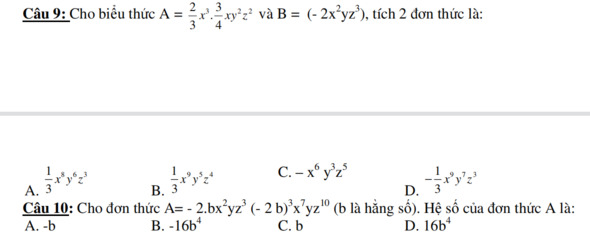Câu 23: Cho biểu thức P =\(\dfrac{14-x}{4-x}\)
. Số các giá trị nguyên của x để P có giá trị nguyên là:
A. 4 B. 5 C. 6 D. 8

Hãy nhập câu hỏi của bạn vào đây, nếu là tài khoản VIP, bạn sẽ được ưu tiên trả lời.

a) Ta có: \(M=\dfrac{8x+1}{4x-5}=\dfrac{8x-10+11}{4x-5}=\dfrac{2\left(x-5\right)+11}{4x-5}=2+\dfrac{11}{4x-5}\)
Để M nhận giá trị nguyên thì \(2+\dfrac{11}{4x-5}\) nhận giá trị nguyên
\(\Rightarrow\dfrac{11}{4x-5}\) nhận giá trị nguyên
\(\Rightarrow11⋮4x-5\)
Vì \(x\in Z\) nên \(4x-5\in Z\)
\(\Rightarrow4x-5\inƯ\left(11\right)=\left\{\pm1;\pm11\right\}\)
\(\Rightarrow x\in\left\{1;\pm1,5;4\right\}\)
Vậy \(x\in\left\{1;4\right\}\) thỏa mãn \(x\in Z\).
b) Ta có: \(A=\dfrac{5}{4-x}\). ĐK: \(x\ne4\)
Nếu 4 - x < 0 thì x > 4 \(\Rightarrow A>0\)
4 - x > 0 thì x < 4 \(\Rightarrow A< 0\)
Để A đạt GTLN thì 4 - x là số nguyên dương nhỏ nhất
\(\Rightarrow4-x=1\Rightarrow x=3\)
\(\Rightarrow A=\dfrac{5}{4-3}=5\)
Vậy MaxA = 5 tại x = 3
c) \(B=\dfrac{8-x}{x-3}\). ĐK: \(x\ne3\).
Ta có: \(B=\dfrac{8-x}{x-3}=\dfrac{-\left(x-8\right)}{x-3}=\dfrac{-\left(x-3\right)+5}{x-3}=\dfrac{5}{x-3}-1\)
Để B đạt giá trị nhỏ nhất thì \(\dfrac{5}{x-3}-1\) nhỏ nhất
\(\Rightarrow\dfrac{5}{x-3}\) nhỏ nhất
Nếu x - 3 > 0 thì x > 3 \(\Rightarrow\dfrac{5}{x-3}>0\)
x - 3 < 0 thì x < 3 \(\Rightarrow\dfrac{5}{x-3}< 0\)
Để \(\dfrac{5}{x-3}\) nhỏ nhất thì x - 3 là số nguyên âm lớn nhất
\(\Rightarrow x-3=-1\Rightarrow x=2\)
\(\Rightarrow B=\dfrac{8-2}{2-3}=-6\)
Vậy MaxB = -6 tại x = 2.
Mình làm sai câu a...
Ta có: \(M=\dfrac{8x+1}{4x-1}=\dfrac{8x-2+3}{4x-1}=\dfrac{2\left(4x-1\right)+3}{4x-1}=2+\dfrac{3}{4x-1}\)
Để M nhận giá trị nguyên thì \(2+\dfrac{3}{4x-1}\) nhận giá trị nguyên
\(\Rightarrow\dfrac{3}{4x-1}\) nhận giá trị nguyên
Vì \(4x-1\in Z\) nên \(4x-1\inƯ\left(3\right)=\left\{\pm1;\pm3\right\}\)
\(\Rightarrow x\in\left\{\pm0,5;0;1\right\}\)
Vậy \(x\in\left\{0;1\right\}\) thỏa mãn \(x\in Z\).

để A xác định
\(\Rightarrow\hept{\begin{cases}x+2\ne0\\x-2\ne0\\x^2\ne4\end{cases}}\Rightarrow x\ne\pm2\)
\(A=\frac{4}{x+2}+\frac{3}{x-2}-\frac{5x-6}{x^2-4}\)
\(A=\frac{4.x-8}{\left(x+2\right).\left(x-2\right)}+\frac{3.x+6}{\left(x-2\right).\left(x+2\right)}-\frac{5x-6}{\left(x-2\right).\left(x+2\right)}\)
\(A=\frac{4x-8+3x+6-5x+6}{\left(x+2\right).\left(x-2\right)}=\frac{2.\left(x+2\right)}{\left(x+2\right).\left(x-2\right)}=\frac{2}{x-2}\)
\(\frac{4}{x+2}+\frac{3}{x-2}-\frac{5x-6}{x^2-4}=\frac{4}{x+2}+\frac{3}{x-2}-\frac{5x-6}{\left(x+2\right)\left(x-2\right)}\)
\(=\frac{4x-8}{\left(x+2\right)\left(x-2\right)}+\frac{3x+4}{\left(x-2\right)\left(x+2\right)}-\frac{5x-6}{\left(x-2\right)\left(x+2\right)}=\frac{4x-8+3x+4-5x+6}{\left(x+2\right)\left(x-2\right)}\)
\(=\frac{2x+2}{\left(x+2\right)\left(x-2\right)}=\frac{2x+2}{x^2-4}\)
C, \(x=4\Rightarrow A=\frac{2x+2}{x^2-4}=\frac{-6}{12}=\frac{-1}{2}\)
d, \(A\inℤ\Leftrightarrow2x+2⋮x^2-4\Leftrightarrow2x^2+2x-2x^2+8⋮x^2-4\Leftrightarrow2x+8⋮x^2-4\)
\(\Leftrightarrow2x^2+8x⋮x^2-4\Leftrightarrow16⋮x^2-4\)
\(x^2-4\inℕ\)
\(\Rightarrow x^2\in\left\{0;4;12\right\}\)
Thử lại thì 12 ko là số chính phương vậy x=0 hoặc x=2 thỏa mãn
mk học lớp 6 mong mn thông cảm nếu có sai sót

Bài 5:
\(C=\frac{2\sqrt{x}-3}{\sqrt{x}-2}=\frac{2(\sqrt{x}-2)+1}{\sqrt{x}-2}=2+\frac{1}{\sqrt{x}-2}\)
Để $C$ nguyên nhỏ nhất thì $\frac{1}{\sqrt{x}-2}$ là số nguyên nhỏ nhất.
$\Rightarrow \sqrt{x}-2$ là ước nguyên âm lớn nhất
$\Rightarrow \sqrt{x}-2=-1$
$\Leftrightarrow x=1$ (thỏa mãn đkxđ)
Bài 6:
$D(\sqrt{x}+1)=x-3$
$D^2(x+2\sqrt{x}+1)=(x-3)^2$
$2D^2\sqrt{x}=(x-3)^2-D^2(x+1)$ nguyên
Với $x$ nguyên ta suy ra $\Rightarrow D=0$ hoặc $\sqrt{x}$ nguyên
Với $D=0\Leftrightarrow x=3$ (tm)
Với $\sqrt{x}$ nguyên:
$D=\frac{(x-1)-2}{\sqrt{x}+1}=\sqrt{x}-1-\frac{2}{\sqrt{x}+1}$
$D$ nguyên khi $\sqrt{x}+1$ là ước của $2$
$\Rightarrow \sqrt{x}+1\in\left\{1;2\right\}$
$\Leftrightarrow x=0; 1$
Vì $x\neq 1$ nên $x=0$.
Vậy $x=0; 3$

Bài 1: ĐKXĐ:`x + 3 ne 0` và `x^2+ x-6 ne 0 ; 2-x ne 0`
`<=> x ne -3 ; (x-2)(x+3) ne 0 ; x ne2`
`<=>x ne -3 ; x ne 2`
b) Với `x ne - 3 ; x ne 2` ta có:
`P= (x+2)/(x+3) - 5/(x^2 +x -6) + 1/(2-x)`
`P = (x+2)/(x+3) - 5/[(x-2)(x+3)] + 1/(2-x)`
`= [(x+2)(x-2)]/[(x-2)(x+3)] - 5/[(x-2)(x+3)] - (x+3)/[(x-2)(x+3)]`
`= (x^2 -4)/[(x-2)(x+3)] - 5/[(x-2)(x+3)] - (x+3)/[(x-2)(x+3)]`
`=(x^2 - 4 - 5 - x-3)/[(x-2)(x+3)]`
`= (x^2 - x-12)/[(x-2)(x+3)]`
`= [(x-4)(x+3)]/[(x-2)(x+3)]`
`= (x-4)/(x-2)`
Vậy `P= (x-4)/(x-2)` với `x ne -3 ; x ne 2`
c) Để `P = -3/4`
`=> (x-4)/(x-2) = -3/4`
`=> 4(x-4) = -3(x-2)`
`<=>4x -16 = -3x + 6`
`<=> 4x + 3x = 6 + 16`
`<=> 7x = 22`
`<=> x= 22/7` (thỏa mãn ĐKXĐ)
Vậy `x = 22/7` thì `P = -3/4`
d) Ta có: `P= (x-4)/(x-2)`
`P= (x-2-2)/(x-2)`
`P= 1 - 2/(x-2)`
Để P nguyên thì `2/(x-2)` nguyên
`=> 2 vdots x-2`
`=> x -2 in Ư(2) ={ 1 ;2 ;-1;-2}`
+) Với `x -2 =1 => x= 3` (thỏa mãn ĐKXĐ)
+) Với `x -2 =2 => x= 4` (thỏa mãn ĐKXĐ)
+) Với `x -2 = -1=> x= 1` (thỏa mãn ĐKXĐ)
+) Với `x -2 = -2 => x= 0`(thỏa mãn ĐKXĐ)
Vậy `x in{ 3 ;4; 1; 0}` thì `P` nguyên
e) Từ `x^2 -9 =0`
`<=> (x-3)(x+3)=0`
`<=> x= 3` hoặc `x= -3`
+) Với `x=3` (thỏa mãn ĐKXĐ) thì:
`P = (3-4)/(3-2)`
`P= -1/1`
`P=-1`
+) Với `x= -3` thì không thỏa mãn ĐKXĐ
Vậy với x= 3 thì `P= -1`

\(B=\frac{5}{x+3}+\frac{3}{x-3}-\frac{5x+3}{x^2-9}\)
\(B=\frac{5}{x+3}+\frac{3}{x-3}-\frac{5x+3}{\left(x-3\right)\left(x+3\right)}\)
B xác định \(\Leftrightarrow\hept{\begin{cases}x-3\ne0\\x+3\ne0\end{cases}\Leftrightarrow}x\ne\pm3\)
Vậy B xác định \(\Leftrightarrow x\ne\pm3\)
\(B=\frac{5}{x+3}+\frac{3}{x-3}-\frac{5x+3}{x^2-9}\)
\(B=\frac{5}{x+3}+\frac{3}{x-3}-\frac{5x+3}{\left(x-3\right)\left(x+3\right)}\)
\(B=\frac{5\left(x-3\right)}{\left(x+3\right)\left(x-3\right)}+\frac{3\left(x+3\right)}{\left(x-3\right)\left(x+3\right)}-\frac{5x+3}{\left(x-3\right)\left(x+3\right)}\)
\(B=\frac{5x-15+3x+9-5x-3}{\left(x+3\right)\left(x-3\right)}\)
\(B=\frac{3x-9}{\left(x+3\right)\left(x-3\right)}\)
\(B=\frac{3\left(x-3\right)}{\left(x+3\right)\left(x-3\right)}\)
\(B=\frac{3}{x+3}\)

a: \(A=\dfrac{x^2-2x+2x^2+4x-3x^2-4}{\left(x-2\right)\left(x+2\right)}=\dfrac{2x-4}{\left(x-2\right)\left(x+2\right)}=\dfrac{2}{x+2}\)
a, \(\dfrac{x}{x+2}\) + \(\dfrac{2x}{x-2}\) -\(\dfrac{3x^2-4}{x^2-4}\)
= \(\dfrac{x}{x+2}+\dfrac{2x}{x-2}-\dfrac{3x^2+4}{x^2-4}\)
= \(\dfrac{x}{x+2}+\dfrac{2x}{x-2}-\dfrac{3x^2+4}{\left(x+2\right)\left(x-2\right)}\)
= \(\dfrac{x\left(x-2\right)+2x\left(x+2\right)-3x^2-4}{\left(x+2\right)\left(x-2\right)}\)
= \(\dfrac{2x-4}{\left(x+2\right)\left(x-2\right)}=\dfrac{2\left(x-2\right)}{\left(x+2\right)\left(x-2\right)}=\dfrac{2}{x+2}\)
Có vài bước mình làm tắc á nha :>

a,ĐK: \(\hept{\begin{cases}x\ne0\\x\ne\pm3\end{cases}}\)
b, \(A=\left(\frac{9}{x\left(x-3\right)\left(x+3\right)}+\frac{1}{x+3}\right):\left(\frac{x-3}{x\left(x+3\right)}-\frac{x}{3\left(x+3\right)}\right)\)
\(=\frac{9+x\left(x-3\right)}{x\left(x-3\right)\left(x+3\right)}:\frac{3\left(x-3\right)-x^2}{3x\left(x+3\right)}\)
\(=\frac{x^2-3x+9}{x\left(x-3\right)\left(x+3\right)}.\frac{3x\left(x+3\right)}{-x^2+3x-9}=\frac{-3}{x-3}\)
c, Với x = 4 thỏa mãn ĐKXĐ thì
\(A=\frac{-3}{4-3}=-3\)
d, \(A\in Z\Rightarrow-3⋮\left(x-3\right)\)
\(\Rightarrow x-3\inƯ\left(-3\right)=\left\{-3;-1;1;3\right\}\Rightarrow x\in\left\{0;2;4;6\right\}\)
Mà \(x\ne0\Rightarrow x\in\left\{2;4;6\right\}\)
A